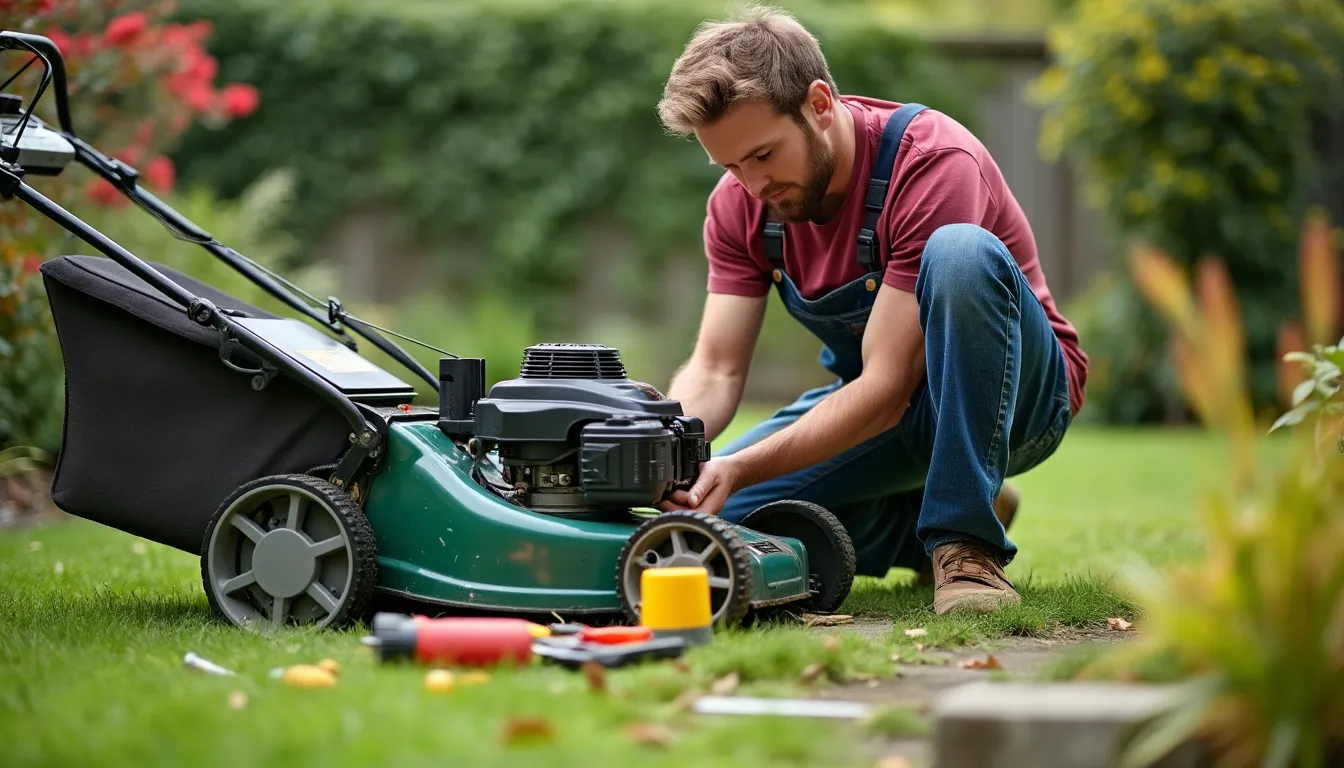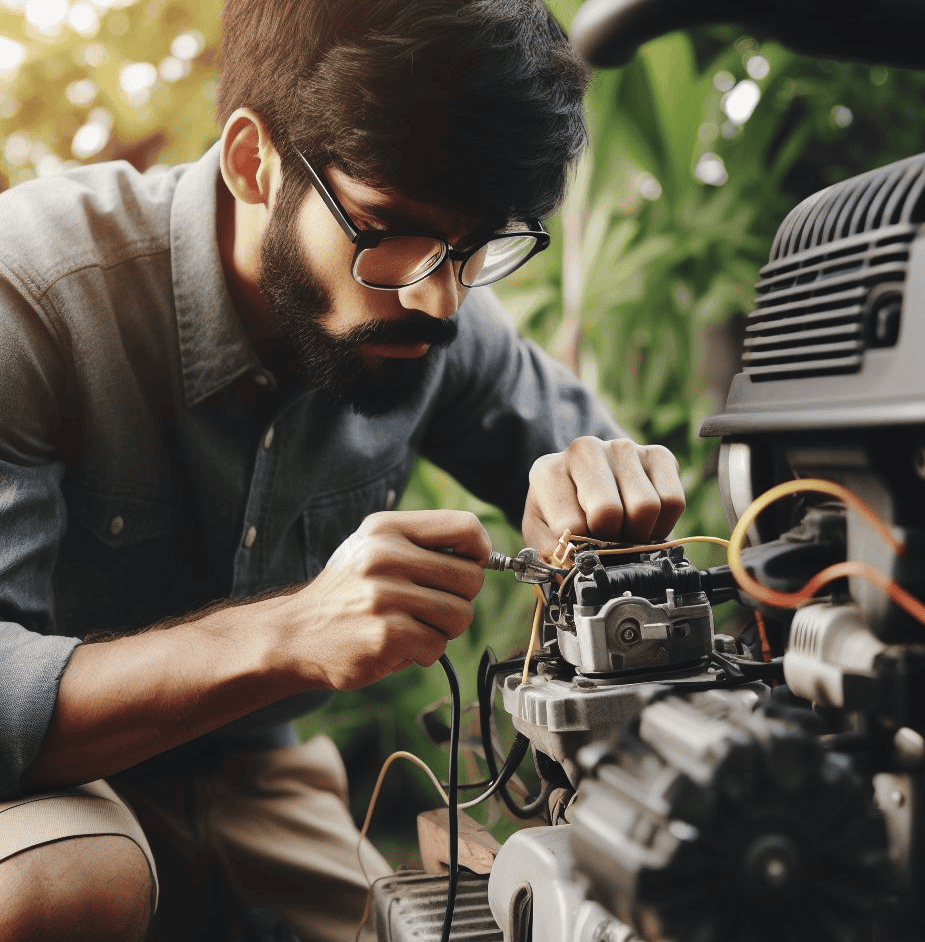
Adjusting the governor on your lawn mower might seem like a small task, but it plays a critical role in ensuring your mower runs smoothly. A properly adjusted governor keeps the engine speed steady, preventing it from running too fast or too slow. This not only extends the life of your mower but also ensures a clean and even cut every time you mow.
However, improper adjustments can lead to serious issues. Imagine your mower’s engine revving uncontrollably, potentially causing damage or even accidents. Learning how to adjust the governor on a lawn mower correctly can save you from these risks and keep your lawn looking pristine.
Understanding the Governor
When you think about your lawn mower’s engine, you might not immediately consider the governor. Yet, this small component plays a big role in how your mower performs. Let’s dive into what a governor is and why it’s so important.
What is a Governor?
A governor in a lawn mower acts like a cruise control system for your engine. It maintains a steady speed, ensuring that your mower doesn’t run too fast or too slow. This consistency is crucial for achieving that perfect cut on your lawn.
Function and Importance
The primary function of a governor is to regulate the engine’s speed. It does this by adjusting the throttle based on the engine load. When the engine faces more resistance, the governor opens the throttle to maintain the set RPM. This ensures that your mower operates efficiently, regardless of the terrain or grass thickness.
Without a properly functioning governor, your engine might rev uncontrollably or stall, leading to uneven cuts and potential damage.
Types of Governors
Generally governors come in different types, each with its unique mechanism:
-
Mechanical Governors: These are the most common in lawn mowers. They use gears and flyweights inside the engine to control speed.
-
Pneumatic Governors: These rely on air pressure to adjust the throttle. They’re less common but still used in some models.
-
Electronic Governors: Found in more advanced mowers, these use sensors and electronic controls to maintain engine speed.
Understanding these types can help you identify which one your mower uses and how to adjust it if needed.
Common Issues with Governors
Even though governors are designed to keep your engine running smoothly, they can encounter problems. Recognizing these issues early can save you from bigger headaches down the road.
Symptoms of Malfunction
A malfunctioning governor can manifest in several ways:
-
Engine Surging: The engine speed fluctuates without any change in load.
-
Inability to Reach Top Speed: The mower struggles to reach its maximum speed.
-
Erratic Speed Control: The engine speed changes unpredictably.
These symptoms indicate that the governor isn’t regulating the engine speed properly.
Causes of Governor Problems
Several factors can lead to governor issues:
-
Worn or Stretched Springs: Over time, the springs in the governor can lose tension, affecting performance.
-
Dirty or Clogged Components: Dirt and debris can interfere with the governor’s operation.
-
Improper Adjustments: If the governor isn’t set correctly, it won’t function as intended.
Regular maintenance and understanding your mower’s engine specifications and line can help prevent these problems. If you’re unsure about the specifics, you might want to troubleshoot a lawn mower or consult the parts lookup system check for detailed guidance.
Preparing for Adjustment
Before you dive into adjusting the governor on your lawn mower, it’s crucial to prepare properly. This preparation ensures not only a smooth adjustment process but also your safety.
Let’s walk through the essential tools you’ll need and the safety precautions you should take.
Tools Required
Having the right tools at hand can make the adjustment process much easier and more efficient. Here’s a list of what you’ll need:
List of Necessary Tools
-
Wrench Set: A set of wrenches is essential for loosening and tightening bolts on the governor arm.
-
Nut Driver: This tool helps in adjusting the governor’s shaft and securing it in place.
-
Screwdriver: Useful for any screws that need adjusting or tightening.
-
Pliers: Handy for manipulating small components if necessary.
Optional Tools for Ease
-
Torque Wrench: Ensures bolts are tightened to the correct specification, preventing over-tightening.
-
Magnetic Tray: Keeps small parts like nuts and bolts from getting lost during the process.
-
Flashlight: Provides better visibility in tight or dimly lit areas of the mower.
Safety Precautions
Safety should always be your top priority when working on machinery. Here are some precautions to keep in mind:
Personal Protective Equipment
-
Safety Glasses: Protect your eyes from debris or accidental splashes of oil.
-
Gloves: Wear gloves to protect your hands from sharp edges and hot surfaces.
-
Ear Protection: If you need to run the engine during adjustments, ear protection can prevent hearing damage.
Safety Measures to Follow
-
Disconnect the Spark Plug: Always disconnect the spark plug before starting any work. This prevents accidental engine starts.
-
Work in a Well-Ventilated Area: Ensure you’re working in a space with good airflow to avoid inhaling fumes.
-
Secure the Mower: Make sure the mower is on a stable surface to prevent it from tipping over during adjustments.
By following this guide, you’ll be well-prepared to adjust your lawn mower’s governor safely and effectively. Remember, preparation is key to a successful adjustment process.
Step-by-Step Adjustment Process
Adjusting the governor on your lawn mower might seem daunting, but breaking it down into simple steps can make it manageable. Let’s walk through each step to ensure your engine runs smoothly and efficiently.
Step 1: Locate the Governor
Detailed Instruction
First, you need to find the governor on your lawn mower. Typically, it’s near the engine’s throttle linkage. Look for a small lever connected to the throttle by a spring or rod. This is your governor arm.
Tools Required
-
Flashlight (for better visibility)
-
Screwdriver
Who Should Try This?
Anyone comfortable with basic engine components can try this step. If you’ve ever changed your mower’s oil or spark plug, you’re ready.
Who Should Not Try This?
If you’re unfamiliar with engine parts or uncomfortable working with machinery, consider seeking help.
Common Mistake to Avoid
Avoid mistaking the throttle linkage for the governor. They are close but serve different functions.
Potential Challenges
The governor might be hard to see due to dirt or debris. Clean the area for a better view.
Pro Tips
Use a flashlight to illuminate the area. It helps in spotting the governor arm easily.
Any Safety Concerns?
Ensure the mower is off and the spark plug is disconnected to prevent accidental starts.
Step 2: Inspect the Governor Linkage
Detailed Instruction
Once you’ve located the governor, inspect the linkage. Check for any bends or wear that might affect performance. The linkage should move freely without obstruction.
Tools Required
-
Pliers
-
Wrench Set
Who Should Try This?
DIY enthusiasts who enjoy tinkering with engines will find this step straightforward.
Who Should Not Try This?
If you’re unsure about identifying bends or wear, consult a professional.
Common Mistake to Avoid
Don’t overlook small bends in the linkage. Even minor issues can impact engine performance.
Potential Challenges
Linkage might be stiff due to rust or debris. Apply a lubricant if necessary.
Pro Tips
Gently bend any misaligned parts back into place using pliers. Ensure everything moves smoothly.
Any Safety Concerns?
Wear gloves to protect your hands from sharp edges or hot surfaces.
Step 3: Adjust the Governor Arm
Detailed Instruction
Now, adjust the governor arm. Loosen the clamp bolt on the arm, then move the arm to set the desired RPM. Tighten the bolt once the adjustment is complete.
Tools Required
-
Nut Driver
-
Torque Wrench (optional)
Who Should Try This?
Those with experience in minor engine adjustments will find this step rewarding.
Who Should Not Try This?
If you’re not confident in adjusting engine components, it’s best to seek assistance.
Common Mistake to Avoid
Avoid over-tightening the bolt. It can damage the governor arm.
Potential Challenges
Finding the right RPM setting might require a few attempts. Be patient.
Pro Tips
Use a torque wrench to ensure the bolt is tightened to the correct specification. This prevents over-tightening.
Any Safety Concerns?
Ensure the mower is stable and won’t tip over during adjustments.
By following these steps, you’ll have your lawn mower’s governor adjusted in no time. Remember, a well-maintained engine not only extends the life of your mower but also ensures a pristine lawn every time. For more tips, check out how to troubleshoot a lawn mower.
Step 4: Test the Governor Adjustment
You’ve made it this far, and now it’s time to see if your hard work has paid off. Testing the governor adjustment ensures that your lawn mower’s engine runs at the optimal speed. This step is crucial for confirming that the adjustments you’ve made are effective and safe.
Detailed Instruction
-
Reconnect the Spark Plug: Before starting the engine, ensure the spark plug is securely connected.
-
Start the Engine: Turn on your lawn mower and let it idle for a few minutes. Listen for any unusual sounds or fluctuations in speed.
-
Observe the Engine Speed: Engage the throttle to full speed and observe the engine’s behavior. The engine should maintain a steady RPM without surging or stalling.
-
Adjust if Necessary: If the engine speed isn’t stable, you may need to revisit the governor arm adjustment. Make small tweaks and test again.
Tools Required
-
Safety Glasses
-
Ear Protection
Who Should Try This?
Anyone who has successfully completed the previous steps and feels comfortable operating the lawn mower can perform this test.
Who Should Not Try This?
If you’re unsure about handling the mower while it’s running, it’s best to seek assistance from someone more experienced.
Common Mistake to Avoid
Don’t rush the testing process. Allow the engine to run for a few minutes to ensure stability.
Potential Challenges
You might encounter minor fluctuations in engine speed. Patience and small adjustments are key.
Pro Tips
Keep a notepad handy to jot down any observations or adjustments needed. This will help you track changes and improvements.
Any Safety Concerns?
Always wear safety glasses and ear protection during this step. Ensure the mower is on a flat surface to prevent tipping.
Step 5: Fine-Tune the Adjustment
Fine-tuning is where you perfect the governor settings to achieve the best performance from your engine. This step ensures that your lawn mower operates efficiently under various conditions.
Detailed Instruction
-
Monitor Engine Performance: Pay attention to how the engine responds to different loads, such as thick grass or inclines.
-
Make Minor Adjustments: Use the nut driver to slightly change the governor arm if needed.
-
Test Again: After each adjustment, test the mower to see if performance improves.
Tools Required
-
Nut Driver
-
Wrench Set
Who Should Try This?
DIY enthusiasts who enjoy optimizing their equipment will find this step rewarding.
Who Should Not Try This?
If you’re not comfortable with making precise adjustments, consider consulting a professional.
Common Mistakes to Avoid
Avoid making large adjustments. Small, incremental changes yield the best results.
Potential Challenges
Finding the perfect setting might take several attempts. Stay patient and persistent.
Pro Tips
Keep a record of each adjustment and its effect on performance. This will help you identify the optimal setting.
Any Safety Concerns?
Ensure the mower is stable and the area is clear of obstacles during testing.
Step 6: Final Inspection and Maintenance
The final step involves a thorough inspection and routine maintenance to keep your engine in top shape. Regular checks prevent future issues and extend the life of your mower.
Detailed Instruction
-
Inspect All Components: Check the governor linkage, springs, and other parts for wear or damage.
-
Clean the Engine Area: Remove any dirt or debris that could affect performance.
-
Lubricate Moving Parts: Apply lubricant to the governor linkage and other moving parts to ensure smooth operation.
Tools Required
-
Pliers
-
Lubricant
Who Should Try This?
Anyone who wants to maintain their lawn mower and prevent future problems should perform this inspection.
Who Should Not Try This?
If you’re unsure about what to look for, seek guidance from a professional.
Common Mistakes to Avoid
Don’t neglect regular maintenance. Consistent care keeps your engine running smoothly.
Potential Challenges
Identifying worn parts can be tricky. Consult your mower’s manual for guidance.
Pro Tips
Set a regular maintenance schedule to keep your mower in peak condition.
Always disconnect the spark plug before performing maintenance to prevent accidental starts. For seasonal care, consider lawn mower winter storage.
Always disconnect the spark plug before performing maintenance to prevent accidental starts.
Briggs and Stratton Lawn Mower Adjustment
When it comes to maintaining your lawn mower, understanding how to adjust the governor is crucial, especially for Briggs and Stratton models. These engines are renowned for their durability and performance, but like any machine, they require regular maintenance to keep running smoothly.
Let’s dive into how you can adjust the governor on a Briggs and Stratton lawn mower, ensuring your engine runs efficiently and your lawn gets that perfect cut every time.
How to Adjust the Governor on a Lawn Mower
Adjusting the governor on your Briggs and Stratton lawn mower involves a few straightforward steps. This process ensures that your engine maintains a consistent speed, which is vital for achieving an even cut. Here’s how you can do it:
-
Disconnecting the Spark Plug: Safety first! Always start by disconnecting the spark plug to prevent accidental starts. This simple step can save you from potential injuries.
-
Locate the Governor Spring: The governor spring plays a pivotal role in controlling the engine speed. It’s usually found near the throttle linkage. Carefully inspect it for any signs of wear or damage.
-
Adjusting the Governor Spring: Use a flat head screwdriver to adjust the tension of the governor spring. This adjustment helps in fine-tuning the engine speed. If the spring is too loose, the engine might not reach its optimal speed. Conversely, if it’s too tight, the engine could over-rev.
-
Move the Governor Lever: Gently move the governor lever to ensure it operates smoothly. This lever should move freely without any resistance. If you notice any stiffness, it might be time to lubricate the moving parts.
-
Check the Governor System: After making adjustments, check the governor system to ensure everything is in place. This includes inspecting the air filter and cable connections. A clean air filter ensures that the engine receives the right amount of air, which is crucial for optimal performance.
-
Test the Engine: Reconnect the spark plug and start the engine. Let it run for a few minutes and observe the speed. The engine should maintain a steady RPM without any fluctuations. If necessary, make minor adjustments to the governor spring until you achieve the desired performance.
Understanding RPM and Top No-Load Speed
When you think about your lawn mower’s performance, understanding RPM (Revolutions Per Minute) and top no-load speed is crucial.
These terms might sound technical, but they play a significant role in how efficiently your mower operates. Let’s break it down so you can get the most out of your machine.
Mechanical Governor and Spring Governors
In the world of lawn mowers, governors act like the unsung heroes. They ensure your engine runs at a consistent speed, regardless of the load.
This consistency is vital for achieving that perfect cut on your lawn. Among the various types of governors, mechanical and spring governors are the most common.
Single Spring Governors
Single spring governors are straightforward yet effective. They use a primary governor spring to control the throttle opening based on engine speed. This setup is simple, making it easy to adjust and maintain. Here’s how it works:
-
Primary Governor Spring: This spring is the heart of the system. It adjusts the throttle to maintain a steady RPM, ensuring your engine doesn’t over-rev or stall.
-
Ease of Maintenance: With fewer components, single spring governors require less maintenance. Regular checks for wear and tear on the spring can keep your mower running smoothly.
Dual Spring Governors
Dual spring governors offer a bit more complexity but provide enhanced control over engine speed. They use two springs to fine-tune the throttle response, making them ideal for varying mowing conditions.
-
Primary Governor Spring: Like in single spring systems, the primary spring maintains the base RPM.
-
Secondary Spring: This additional spring allows for finer adjustments, providing better control over the engine’s no-load speed. It ensures that your mower adapts to changes in terrain or grass thickness without losing power.
|
Feature |
Single Spring Governors |
Dual Spring Governors |
|---|---|---|
|
Components |
One spring |
Two springs |
|
Maintenance |
Simple |
Moderate |
|
Control |
Basic |
Enhanced |
|
Ideal for |
Flat lawns |
Varied terrains |
Understanding these systems can help you choose the right governor for your needs. Whether you prefer the simplicity of a single spring or the precision of dual springs, knowing how they work empowers you to make informed decisions about your lawn mower’s maintenance.
You’ve now mastered the art of adjusting your lawn mower’s governor. This process ensures your mower runs smoothly, delivering a consistent cut every time. Regular maintenance is key to keeping your engine in top shape. By routinely checking and adjusting the governor, you prevent potential issues and extend the life of your mower.
If you ever feel unsure or encounter complex problems, don’t hesitate to seek professional help. Remember, a well-maintained mower not only enhances your lawn’s appearance but also saves you time and effort in the long run.

Michael Miller is a gardening enthusiast with a green thumb and a knack for fixing anything related to the world of plants. He envisions owning a vineyard in the future, a testament to his deep love for cultivation. Happily married with two kids in vibrant Tokyo, Japan, Michael’s life is a blend of botanical beauty and family bonds. Join him on his journey where gardening passion meets a vision for the future, and explore the secrets of cultivating a harmonious life.


